
Best Printers for 300GSM Card [Tried & Tested]
If you use printing services at least once in a while, then you already know that the cardstock paper weight is one of the most important aspects involved in the printing process. But what about when you want to print 300gsm cardstock? Is there a special kind of printer to choose? Or is it just any printer that’s good enough? In this case — no.You really need to be mindful and make sure you have the right hardware and software combination so as not to mess your project up.
In the real world, not every printer has the ability to print on 300GSM cards. This is because there are many types of cardstock, each with their own specific weight. For example, there are those meant for invitations and business cards while others are better suited for photo books and gift cards. The key to finding a good cardstock printer is knowing what you’re looking for in your publishing project as well as where to find it.
I’ve spent countless hours testing out a variety of printers for printing on cardstock. And it wasn’t easy running through all the brands, models, and price points. Below is a list of the best printers for 300gsm cardstock. I hope this list will help you choose the right printer for your next job involving cardstock with thicker than regular paper thickness.
- Best Printers for 300GSM Card [Tried & Tested]
- List of 7 Best Printers for 300GSM Card
- 1. HP OfficeJet Pro 6978 All-in-One Wireless Printer
- 2. Brother HL-L2350DW Monochrome Laser Printer
- 3. Epson EcoTank ET-2720 Wireless Printer
- 4. HP ENVY Photo 7155 All-in-One Photo Printer
- 5. HP OfficeJet Pro 8035 All-in-One Wireless Printer
- 6. Canon Pixma iX6820 Wireless Business Printer
- 7. Brother MFC-J895DW All-In-One Inkjet Printer
- Factors to Consider Before Buying Printer for 300GSM Card
- Frequently Asked Questions
- Will a 300gsm card go through a printer?
- Can a printer print on a 300gsm card?
- What printer can print on 300gsm paper?
- What GSM card will go through a printer?
- What is a Cardstock Printer?
- What Should a Cardstock Printer Have?
- How To Select The Best Cardstock Printer?
- Can the cardboard pass through a printer?
- Is 300GSM Paper Thick?
- Which GSM Paper is Better for Photo Printing?
- Which GSM paper is better for an inkjet printer?
List of 7 Best Printers for 300GSM Card
1. HP OfficeJet Pro 6978 All-in-One Wireless Printer
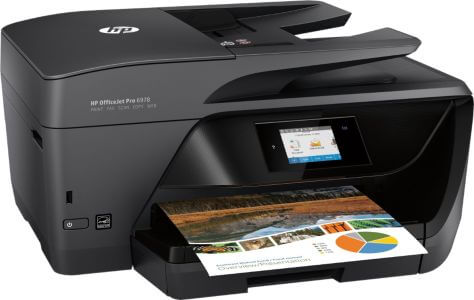
Consistent, professional-quality printing in your home or small workgroups is easier than ever with OfficeJet Pro 6978 – HP’s highest selling all-in-one printer. Produce fast color documents and photos with Instant Ink ready so you’ll always have premium ink when you need it. OfficeJet Pro 6978 is packed with advanced security features plus automated functions to streamline the process of printing from your smartphone, tablet or notebook PC. Be more efficient with a touchscreen that includes new intuitive icons for copying, scanning, and faxing. You can use the large LCD display or mobile app from your smartphone or tablet to check the printer status at any time.
This HP OfficeJet Pro 6978 can print, scan, and fax, allowing you to seamlessly manage your day. It prints professional-quality color for 50% less than lasers, saves paper with automatic two-sided printing and handles more tasks without slowing down. Networking is available with built-in wired Ethernet LAN and wireless networking capabilities as well.
This HP Printer is suitable for printing on all types of paper, photos, 300gm card stock and ordinary sized envelopes. You can rely on it to handle all of your everyday business tasks smoothly and efficiently as it comes with a one year warranty and 24/7 web support.
Key Features:
- Print wirelessly from virtually anywhere
- Produce fast professional-quality color for 50% less than lasers
- Save paper with automatic two-sided printing and copying
- Create professional documents with an intuitive user interface
- Print lab-quality photos using HP Advanced Photo Paper
- Get started quickly with easy setup and built-in Wi-Fi connectivity
- 1 year hardware warranty
2. Brother HL-L2350DW Monochrome Laser Printer
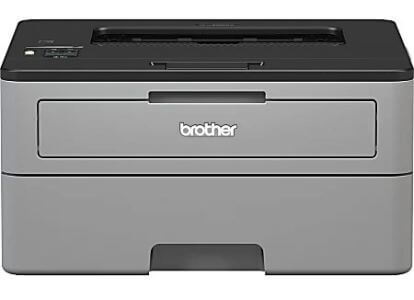
Work smarter and live better with the HL-L2350DW — a dedicated printer engineered for increased efficiency and built to handle your evolving printing needs. You can save more time and stay productive with this monochrome laser printer. Designed for small workgroups looking to print from anywhere, this multifunction printer produces high-quality text and graphics at speeds up to 32 pages-per-minute. A 250-sheet paper capacity helps improve efficiency with less refills and supports letter or legal sized paper. Enjoy flexible printing options with a manual feed slot that handles a variety of papers, including envelopes and card stock.
With its advanced features and sophisticated design, this high speed printer is powerful enough to keep up with any demanding work pace. It ships ready for Amazon Dash Replenishment, which automatically reorders toner when you are running low.
This feature-rich laser printer offers automatic double-sided printing and wired and wireless connection capabilities. Connect your way with wireless (802.11b/g/n) and wired connectivity that includes one USB 2.0 port.
Key Features:
- Printing speed of 32ppm
- 250 sheet paper capacity
- Ideal for cardstock printing
- Wireless and USB connectivity
3. Epson EcoTank ET-2720 Wireless Printer
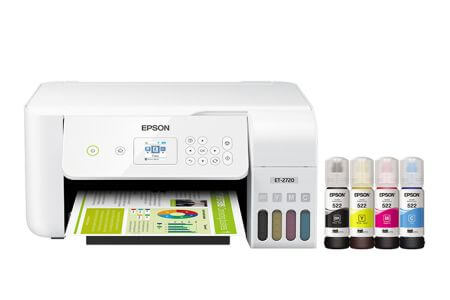
Epson EcoTank ET-2720 all-in-one printer is designed to save you money and help the earth. Printing, scanning, and copying―at up to 50% less cost per page than comparable inkjet models―are just a few of its many valuable features. The EcoTank ET-2720 features wireless and voice activated printing, you can print from your smart device with its intuitive Epson Smart Panel App.
Featuring full color printing and scanning as well as a high-resolution flatbed scanner, the Epson EcoTank ET-2720 All-in-One Supertank Printer is an office workhorse that will impress your colleagues with its speedy print speeds and impressive visuals. With its high-capacity ink system consisting of refillable cartridges, you can use for up to two years or more with each replacement set of ink bottles; offer an estimated savings of up to 90% compared to replacing individual ink cartridges. The EcoTank ET-2720 features Micro Piezo technology that produces exceptional graphic quality and sharp text on virtually any type of paper―all without using messy heat elements.
Key Features:
- Modern Connectivity – Wireless, voice activated
- 2 Year Warranty including full unit replacement
- High Print Quality
- Save 90% with ink replacement
4. HP ENVY Photo 7155 All-in-One Photo Printer
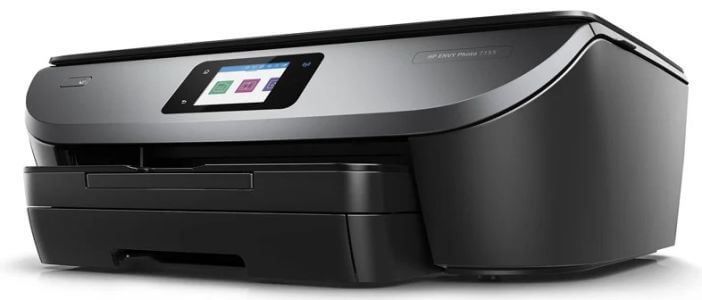
” target=”blank” rel=”nofollow” background=”#fd710d” color=”#ffffff” size=”10″ center=”yes” icon=”icon: amazon”]Check Latest Price on Amazon[/su_button]
Bring home the power of this sleek photo printer and start printing your favorite memories on demand. The HP ENVY Photo 7155 All-in-One photo Printer is designed to print the best photos and help you do it for less, right at home. With wireless printing and a built-in color touchscreen that makes it simple to print from almost anywhere, the ENVY Photo 7155 is compatible with the technologies you use everyday.
This photo printer can be connected to your smartphone, tablet, or laptop using the HP Smart app, so you can print from social media platforms such as Facebook, Google Photos, and Dropbox. It also allows printing from an SD card with dedicated paper trays that automatically adjust to match print settings and paper type. Also, this printer comes full of premium HP innovations that save you time, whether refilling ink bottles or printing photos for less than 5 cents each – all with HP Instant Ink (subscription required).
Key Features:
- Wireless connectivity
- Variety of paper sizes supported
- 1 Year hardware warranty
- Ideal for printing photos
5. HP OfficeJet Pro 8035 All-in-One Wireless Printer

A wireless printer and scanner, with speedy printing at 20 pages per minute. This home office printer offers fax and scan-to-USB capabilities. The All-in-One is 14% smaller than the previous generation and over 40% faster for easier collaboration between colleagues. This printer helps you eliminate steps in repetitive tasks with HP Smart tasks, 50% faster and free of charge. To help you get organized, the printer syncs to QuickBooks, Google Drive, Microsoft OneDrive, Evernote and Slack.
It also has built-in security essentials like basic encryption; password protection; Wi-Fi security; document protection and HP Sprocket 2 in 1 mobile app printing technology delivering instant prints from phones or tablets ready in minutes with no computer needed. Using HP Instant Ink Business, cartridges automatically deliver premium ink during defined usage periods so you can conveniently buy less but print more. The Officejet Pro also has Alexa integration built into it – this is an excellent feature for people looking for their printers to be part of their smart home ecosystem.
Key Features:
- Built-in security features
- Wireless printing
- Self healing Wi-Fi
- Sustainable built
6. Canon Pixma iX6820 Wireless Business Printer
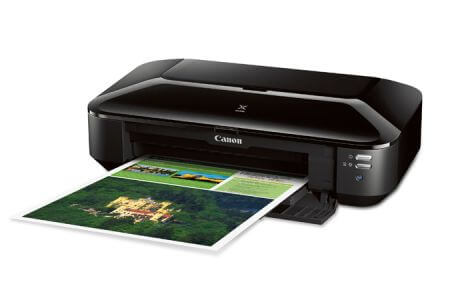
The Canon Pixma iX6820 Wireless Business Printer ensures you will print with ease for years to come. This printer sports a sleek design that is ideal for any desktop environment. It offers 5 individual ink tank systems for smooth color images and text with a maximum resolution of 9600 x 2400 dpi. Which gives you the ability to print the most graphics-intensive documents without the wait.
There is also a large LCD display panel that gives you easy access to printing tools, print settings, and printer status. For easy navigation, this wireless business printer offers wireless networking options, such as a built in Ethernet port to allow clients to connect wirelessly to your network. Another handy feature is 802.11b/g/n 2.4 GHz wireless connectivity that allows you to connect up to 5 computers or devices simultaneously by Wi-Fi at home or in the office without the hassle of cords or cables. You can also freely archive data in cloud services such as Dropbox for more convenience, productivity and efficiency with workgroups.
The Pixma iX6820 Wireless Business Printer incorporates an Auto Document Feeder with a capacity to hold up to 150 sheets with an automatic document size detection and straight line paper path for easy loading of folded media.
Key Features:
- Compatible with most Operating systems
- 150 sheet capacity of auto sheet feeder
- 9600×2400 dpi print resolution
7. Brother MFC-J895DW All-In-One Inkjet Printer
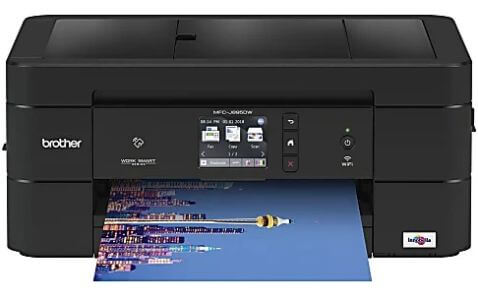
Get optimal functionality and versatility with the Brother Inkjet Printer, MFC-J895DW. It combines a multifunction color inkjet printer with a 3.8 cm touchscreen and wireless functionality. Ideal for printing on 300 gsm cardstock, it offers a unique suite of smart and intuitive features. Print ID cards, photos, or documents easily and quickly at home or on the go with auto two-sided printing and copying.
The convenient mobile app lets you scan or print from your smartphone or tablet from anywhere in your home or office. Print wirelessly from Mac or PC using AirPrint, Google Cloud Print and Brother iPrint&Scan directly from the printer. Enjoy cloud connectivity with direct printing and scanning options to popular Cloud services including Dropbox, Box, OneDrive, Google Drive, and FTP. The MFCJ895DW is also Amazon dash replenishment enabled, after activating this feature the printer will measure its ink level and order more when its low so you don’t have to worry about skipping a beat when printing important documents or pictures.
Key Features:
- Wireless, Ethernet and USB connectivity
- Cloud connectivity
- Great for printing on 300gsm card
Factors to Consider Before Buying Printer for 300GSM Card
If you’re looking to buy a new printer for a 300GSM card, there are lots of factors to take into consideration before deciding which model is right for you. How much space do you have available? Will it be used by more than one person? What specifications will you need in order to meet your desired output?
Printer Type – Laser vs Inkjet
One of the biggest decisions that should be made before purchasing a printer is whether to go with an inkjet or a laser model. While both have their advantages and disadvantages, figuring out which one best fits your needs can help narrow down your options significantly.
Laser printers offer better print quality for text than inkjets, and they’re faster when it comes to printing large volumes of documents. They also have cheaper running costs—the cartridges last longer and cost less per page. Laser printers are great for printing text-heavy documents like school papers, reports, and letters. These printers aren’t ideal for photos and graphics, however, since they don’t produce accurate color reproduction—and most models can’t print on cardstock at all.
Inkjets are better suited for producing high-quality images because they can achieve more accurate color reproduction. They’re also generally smaller in size than laser printers, making them good choices if you plan on moving the machine around a lot.
Also, the inkjet printers are much more suited for 300 gsm cardstock than laser printers. It’s because lasers tend to heat up the paper and this can melt the ink on the paper. As a result, you won’t get the desired prints.
Inkjet printers also have a more even spread of ink on the paper, which means that you will get sharper and brighter prints. Laser printers, on the other hand, work better with lighter paper as that doesn’t get overheated as much and keeps the print quality consistent.
Cardstock Weight
You want a printer that can handle whatever type of material you plan on using. A 300gsm cardstock is one of the heavier types of cardstock out there. It’s very thick and rigid, which means it can get stuck in certain types of printers that don’t have adjustable paper guides or trays—or in some cases that have fixed trays. To ensure that your printer can handle any type of cardstock, look for one with adjustable paper guides and trays.
Print Quality
When buying any printer, make sure that the quality is good so that your documents look professional and crisp. If possible, check out samples from other people who have purchased the same printer before making your decision. You should look for a printer that offers high-quality printing with vivid colors and sharp text. The quality of the printed image can be judged by looking at its resolution, clarity and consistency.
Compatibility
Compatibility is another factor that you need to consider before buying a printer for 300 GSM cards. There are different types of printers available in the market and each one has its compatibility with specific operating systems and software programs. So, make sure that your printer is compatible with your computer system as well as other software programs so that it does not cause any technical glitches during the printing process.
Connectivity
One of the most important things when it comes to printers is connectivity. There are three different types of connectivity: wireless, wired and cellular. Wireless printers have no cables attached, which means they’re easy to move around and can print from different locations. Wired printers require a cable connection in order to print, while cell phone printers connect via Bluetooth or Wi-Fi networks.
A 300gsm card printer is more than likely going to be used in an office environment where multiple people will need to use the printer. Therefore, it is important that the printer has a high level of connectivity. This means that the printer should have USB ports, Wi-Fi capabilities, and Ethernet support. If you are planning to print from different locations, then you need a printer that has a WiFi connection. You can also opt for printers that have Ethernet cables, which will enable you to print from desktop computers and laptops.
Printing Speed
The speed at which a printer can print is another important consideration when shopping for one that will handle heavier material like cardstock or large quantities of paper. If you’re printing large batches or high volumes often, then it’s worth investing in a model that has faster speeds and an automatic feeder that can load multiple sheets at once.
Any 300gsm card printer needs to have a fast printing speed so as not to slow down workflow in the office environment. When searching for a 300gsm card printer, you should look at how many pages per minute it can produce and compare this to other models from different manufacturers.
It’s also worth considering whether you want to buy a single or dual-sided 300gsm card printer since this might affect the speed of printing.
Features
The features offered by the product will also help you decide whether it is right fit for your needs or not. Check if it offers features like automatic duplexing (printing on both sides), wireless connectivity and Ethernet support etc. If possible, try out these features as well before making any purchase decision so that you know how well they work in real-life scenarios as well.
Ink Type
When it comes to printing on thick stock, you have to consider ink setup. Your printer will probably settle for a dye-based ink setup, but if you haven’t already upgraded, you’re holding yourself back from the possibilities of pigment-based ink. Pigment-based ink is much more durable, and won’t fade with time or exposure to sunlight. Dye-based ink can also be more expensive than pigment in the long run, because it requires more frequent replacement. But if you’ve got a dye-based printer and want to upgrade, don’t despair—the switch is possible, though it’s not always simple. You’ll need to clean out all traces of the old ink before installing a new cartridge.
Cost
Although this should not be the main factor, it is still obviously a factor in this decision. You need to determine whether buying a cheaper machine will actually save you money in the long run. Your best bet is to take a look at the cost of consumables (ink and paper) for each model and compare them against the sticker price of the machine itself. Some printers come with starter kits that include extra ink and some paper stock so you can get started right away—this might also help determine which one suits your needs best.
Frequently Asked Questions
Will a 300gsm card go through a printer?
In a friendly tone: Yes, you can print on a 300gsm card in an inkjet printer, however not all printers will be able to handle the thickness of the card. Some will get jammed, some will throw up an error message and stop before they break something and some will get halfway through the printing process and then announce that you have a paper jam!
Can a printer print on a 300gsm card?
The short answer is: most printers can’t print on 300gsm paper. Cardstock that’s around 300gsm (give or take) is considered pretty thick, and many home printers are not equipped to handle it. That said, there’s a bit more to the story.
When choosing paper for your project, you’ll need to consider what the recommended weight is for your specific printer model. You can find this information in your printer manual, or simply by searching online (i.e., “recommended paper weight for [printer make and model]”). The biggest factor in determining whether you can use heavier cardstock with your printer is whether it has a straight or curved paper path.
If your printer has a curved path, then it’s unlikely that it will be able to handle heavy cardstock; thicker paper could easily get caught on the bends and creases. If it has a straight path (most office printers do), then you’ll likely be able to use a thicker cardstock—though you may still want to stick with cardstock that’s more in the 160–220gsm range just to be safe.
What printer can print on 300gsm paper?
Printers that can print on 300gsm paper include the Canon PIXMA PRO-100, HP Officejet Pro 7740 Wide Format All-in-One Printer, Epson Expression Premium ET-7700 EcoTank All-in-One Supertank Printer, Canon Pixma TS9521C and Epson EcoTank ET-2760. These printers are not limited to only printing on 300gsm paper, as they may be able to handle other types of paper as well.
What GSM card will go through a printer?
This is a common question we get asked and it’s actually not as simple as it sounds. GSM is often used to describe the thickness of paper, but there are more factors than just paper weight that will make a card easy or difficult to feed through a printer. It’s also important to consider what type of printer you’re using, since some are better suited than others for printing on heavier cards. Here’s some information that might help:
The proper GSM weight for a card will depend on which type of printer you’re using. Printers vary in the minimum and maximum weights they can handle. For example, if you’re using an inkjet printer, the minimum weight would be something like 100 GSM (grams per square meter). For printers like laser printers and copiers, minimums might be around 150 or 180 GSM. If you go beyond the maximum weight (usually about 300 or 400 GSM), you’ll start to get serious problems with jamming and misfeeds.
If you want to do double-sided printing, most printers require a lower weight for the back side—usually no more than 140 or 160 GSM. An easy way to test a card is to check your printer’s manual.
What is a Cardstock Printer?
A cardstock printer is a type of printer designed specifically to print on heavy paper like cardstock, which could be anywhere from 90 to 110 pound paper weight. This weight is much thicker than standard paper that would be used in regular laser printers and so it requires a specific type of printer that can handle the heavier paper.
What Should a Cardstock Printer Have?
There are many different types of cardstock printers available, ranging from expensive high-volume commercial printers to smaller desktop options. The main thing you’ll want to look for in a cardstock printer is the ability to print double-sided on cardstock. The more expensive the printer you get, the more features it will have and the better it will be able to print photos and graphics.
How To Select The Best Cardstock Printer?
The best cardstock printers are those that can print on the cardboard without damaging it. There are many printers that are available in the market today, but only few will be able to meet your needs and requirements. In order to find the best printer for your needs, you need to first determine what your needs are. Do you want a printer that prints on thick cardstock? Or do you want a printer that is small and portable? Do you plan on using it for business purposes? Do you need to print from your phone or tablet? These are just some of the things to consider when looking for the right printer.
Can the cardboard pass through a printer?
Some printers are designed to print on thick papers while others don’t. So, the first thing to consider is the thickness of the card. Cardboard is usually 0.17mm thick, but some printers can only print on paper or cardboard that is 0.08mm or less in thickness. If you want to make your own business cards, then you will need to find a printer that can handle the thickness of your cardstock.
Is 300GSM Paper Thick?
Yes. 300 GSM (grams per square meter) means that the paper is almost 3 times as thick as standard copy paper (80 GSM). It’s an ideal weight for printing business cards or other documents that require a little more substance than standard copy paper offers.
Which GSM Paper is Better for Photo Printing?
When people ask which GSM paper is better for an inkjet printer, it all comes down to the type of paper you’re using. For example, most people who print photos use glossy paper because it’s meant to produce a shiny finish and prevent smudging or smearing. If you’re going to give your images that glossy look, you’re going to need a heavier weight paper with a higher GSM. You definitely want something thick enough to last, but not so heavy that it jams up your printer or causes ink problems like smudging or running. For this type of paper, we recommend 210gsm—it’s ideal for glossy photo printing, whether you’re printing at home or using an online service like Printopia. This weight is also great for professional-quality projects like brochures and posters.
Which GSM paper is better for an inkjet printer?
There’s no standard GSM measurement that works best across every model, there is a general rule you can follow. When using an inkjet printer with a photo quality setting or photo quality ink cartridges, you’ll want to use a GSM paper that measures at least 100gsm and for maximum quality photos and documents, 150gsm will give you the best results.
The best thing to do is to try out different types of paper and see which one gives you the results you want. If you’re looking for something thin and light, go for 80 GSM; if you prefer printing on a thicker stock, go for 120. The most important thing to remember is not to choose any paper that’s too thin or flimsy—it might get stuck in your printer.
- What Are Ink Subscriptions? - December 12, 2022
- How To Get a Gel Pen To Work Again - December 12, 2022
- Best Pens For Teachers - December 11, 2022